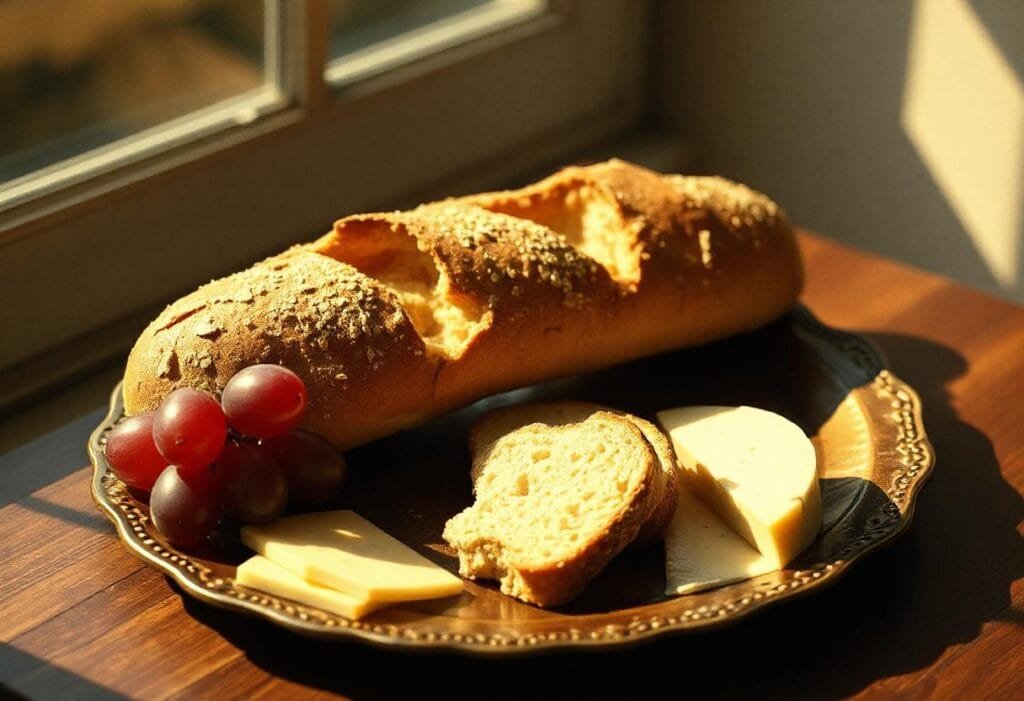Table of Contents
Introduction: Discover the Art of Perfect French Bread Recipe

It can be described as following a trail of accumulated appreciation and embarking on an emotional experience, such as smelling the sweet aroma of bread at a bakery. The assortment of the bread that is being served in the café is large and wide, but the French bread seems to be more appealing in terms of its look with the crust which is well-golden, and the seductive crumb inside. French bread couldn’t possibly be made at home – Or could it?
If you try this easy French bread recipe, you’ll soon see that it is. This article will show how French bread should be prepared from the preparation of the raw materials to how the bread is baked so that by the end of the baking process you can produce that crusty delicious bread that you expect from a baking firm.
Ingredients: The Essentials for Perfect French Bread Recipe
- All-Purpose Flour: 3 ½ cups (450 gm)
- Tip: To try as a variation, some of the all-purpose flour can be swapped with either bread flour.
- Warm Water: 1 ¼ cups / 300 milliliters
- Tip: The water ought to be warm, but not hot, so as not to kill the yeast that has been added to the mixture.
- Olive Oil: 2 tablespoons (30 milliliters)
- Tip: They also lead to increased improvement of the bread, improvement of the moisture content in the bread, and the perfect nutritional value of the bread.
- Active Dry Yeast: 2 ¼ teaspoon or seven grams or one packet
- Tip: Before baking, be sure that you have used active yeast in your recipe. In case it is a perishable product or food item, ensure that it has not expired, and when storing ensure that the area is cold and dry.
- Salt: For 1 tsp = 5.6 grams BP, then 1 ½ tsp is = 9 grams BP
- Tip: Salt also helps to give bread more flavor, and it also regulates the rate of fermentation of the yeast.
- Sugar: 1 teaspoon (4 grams)
- Tip: Sugar helps yeast grow by making it go up and also giving it flavor.
Preparation: Getting Started with Your French Bread Recipe
As a preparation step, assemble all your cooking utensils and tools that will be used in the preparation process. To make the bread you will require a big bowl, a scraper, a baking sheet or pizza stone, baking paper, and a towel. Using a stand mixer with a dough hook is useful, however, is not completely necessary.
Check Out: Sourdough Banana Bread – Flavour#27.
Step-by-Step Instructions for French Bread Recipe
- Mixing the Dough
- In a small bowl of warm water, add sugar and yeast and mix it. Mix them gently and allow them to stand for about 5–10 minutes, and they will turn to froth. Thus, it helps to confirm that the yeast is alive and active to do its work in the process.
- In a large bowl add the flour and salt, then mix them up by using a whisk. In the center, make a hole and pour the yeast mixture and olive oil into the well-made flour. In case you are using a stand mixer, attach the dough hook and mix at low speed when the ingredients start combining into a dough.
- In the case of mixing by hand, one has to use a wooden spoon while mixing the ingredients and this should result in a rough dough. Next, transfer it to a slightly more floury surface and knead it for most of 10–15 minutes or so until it no longer feels sticky, but is properly smooth and springy.
- Kneading and Rising
- In cases when the stand mixer is utilized, then it is kneaded at medium speed for about 5–7 minutes up to smooth and elastic dough. Depending on the consistency of the dough, you could have to add a little more flour.
- Knead on a floured surface and then transfer to an oiled bowl and the towel then cover it. Put it in a warm, draft-free environment and allow it to rise for about an hour and a half to two hours, or until it has doubled its size.
- Knead the dough gently to expel most of the gas in it, and then transfer it to a cutter that has been dusted with flour. Rub it for some time and then pat it with your hands for about 5–10 minutes until it loses most of its volume and then forms a loaf. For normal French bread, you could shape it into a long, thin loaf or two normal-shaped loaves.
- Shaping the Loaf
- If you want to achieve the typical French bread appearance, you have to elongate your dough by stretching and rolling the dough into a 12-inch (30 centimeters) piece. Transfer the shaped loaf to a greased parchment or, for best results, to a floured pizza stone.
- But it is also possible to divide the dough into two equal portions, and then shape each portion into small loaves. Spoon the batter into round cakes, round, pour about 6 inches (15 centimeters) between the loaves on the baking sheet.
- With a sharp knife or a razor blade, gently make a few slashing incisions across the top of the loaf. This not only gives the bread its characteristic look but also assists it to expand necessarily when baking.
- Baking to Perfection
- As for the type of oven, it is most preferred that a particular oven should be preheated to a temperature of 450°F or 230°C. Put a small dish that is oven-safe and has some water inside on the lower rack, this enables steam formation and helps in caramelization.
- Bake the bread for approximately 25–30 minutes; the crust should be golden brown and when the bread is tapped on the bottom it should have the ‘thump’ sound. If you’re using a pizza stone, chances are, it may brown faster compared to a normal baking tray, do check from time to time.
- Take the bread out of the oven and let it cool in wire racks before you can serve it for slicing. It also enables the interior part of the dish to cool down as well as assists in the preparation of slicing the dish.
Variations: Customize Your French Bread Recipe

- Herb French Bread: Just sprinkle some rosemary, thyme, or basil in a finer form to the dough-making process for herb-enriched bread.
- Cheese French Bread: You can use such shredded cheese as Parmesan or Gruyère, adding it directly into the dough or as a topping before the cheese bread is baked.
- Olive and Sun-Dried Tomato Bread: Add chopped olives or sun-dried tomatoes to freshly chopped spinach to enhance the dish and give it a Mediterranean feel.
- Sweet French Bread: A tablespoon of raisins or dried cranberries can also be placed down as are into it with a pinch of cinnamon for a slightly sweet twist.
Tips and Tricks: Expert Advice for Perfect French Bread Every Time
- Use a Kitchen Scale: Using weight to measure your ingredients serves some purpose, some purpose, ensuring that you get accurate measurements of your bread.
- Monitor Dough Consistency: It should be quite shiny and, wherever possible, it should not be tacky When touched it should not be perfectly slippery but rather sticky. If the mixture is too dry, you should add some water to it, while if it is too soft, you should try to add some flour to it.
- Create Steam in the Oven: Another benefit attributed to the steam from the water dish is the development of the perfect crisp on the skin of your poultry. They also can incorporate water into the loaf and put it into the oven, or put a little water into the baked loaf and put it into the oven.
- Check Bread Temperature: And that your bread is well baked, stick a food thermometer in the middle of the loaf. The temperature inside the oven has to vary between 190-210, depending on the type of bread being cooked. This I know will come out very hot; ensure that you do not touch this thermometer on to get the right temperature of the pan. Be careful not to touch the thermometer on this to obtain the correct temperature of the pan.
Conclusion: Enjoying Your French Bread Recipe
French slices of bread baking in the home kitchen is probably one of the most fulfilling home baking experiences. Examining the procedure starting from the time you prepare the dough, kneading it and finally to the time when one can take a bite of a warm well-baked loaf of bread is both fulfilling and pleasing. Even when it is still hot and consumed with a dab of butter or turned into a sandwich, homemade French bread is all that you need.
So, get your French bread ingredients ready, go through this detailed French bread recipe, and enjoy the process of baking. So, the appetizing smell of French bread baked in your kitchen will soon come to your plate and every piece is something worth the bite.
For more info: Click Here.
FAQs: French Bread Recipe
Can I use whole wheat flour in this French bread recipe?
Yes, but all-purpose flour can be replaced by whole wheat flour partially; the amount of liquid and time for kneading has to be adjusted all the same.
What if my dough isn’t rising properly?
Also, make sure you use active yeast and that the dough is left in a warm area and away from the draft. Normally, if the dough is not rising then there are two likely possibilities, first, it could be that the yeast had lost its functionality or second the temperature of preparation must have been too low.
Why did my French bread turn out dense?
There are several things that can take you to a dense bread, namely under kneading, no adequate rising time, or excessive addition of flour. Factors affecting kneading and rising time should be put into consideration notably to get that lighter loaf.



